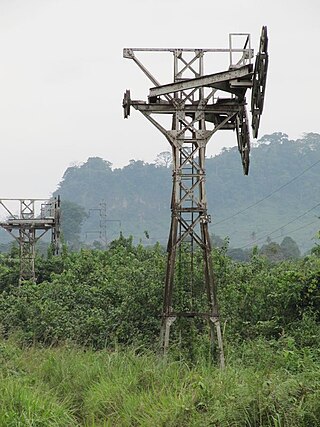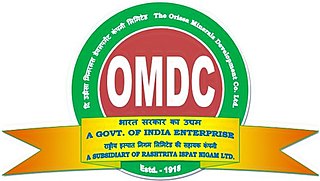
Lecht Mine is a former iron and manganese mining site located in the parish of Kirkmichael, Moray, Scotland. Today only the building of the crushing plant remains. It is a listed building of Category B, HB number 8924.

Lecht Mine is a former iron and manganese mining site located in the parish of Kirkmichael, Moray, Scotland. Today only the building of the crushing plant remains. It is a listed building of Category B, HB number 8924.
Iron ore was mined between 1730 and 1737, whereas, from 1841 on, manganese was mined. Due to decreasing prices, operations ceased again in 1846. At the peak, over 60 men worked at the mine.
In the 1920s iron ore from the Lecht was analysed in order to possibly justify the building of a railway to Tomintoul, but the results were not satisfying.
In 1983, the building was restored by Moray District Council.

Iron ores are rocks and minerals from which metallic iron can be economically extracted. The ores are usually rich in iron oxides and vary in color from dark grey, bright yellow, or deep purple to rusty red. The iron is usually found in the form of magnetite (Fe
3O
4, 72.4% Fe), hematite (Fe
2O
3, 69.9% Fe), goethite (FeO(OH), 62.9% Fe), limonite (FeO(OH)·n(H2O), 55% Fe), or siderite (FeCO3, 48.2% Fe).

Spiegeleisen is a ferromanganese alloy containing approximately 15% manganese and small quantities of carbon and silicon. Spiegeleisen is sometimes also referred to as specular pig iron, Spiegel iron, just Spiegel, or Bisalloy.

Rhodochrosite is a manganese carbonate mineral with chemical composition MnCO3. In its pure form (rare), it is typically a rose-red colour, but it can also be shades of pink to pale brown. It streaks white, and its Mohs hardness varies between 3.5 and 4.5. Its specific gravity is between 3.45 and 3.6. The crystal system of rhodochrosite is trigonal, with a structure and cleavage in the carbonate rhombohedral system. The carbonate ions (CO2−
3) are arranged in a triangular planar configuration, and the manganese ions (Mn2+) are surrounded by six oxygen ions in an octahedral arrangement. The MnO6 octahedra and CO3 triangles are linked together to form a three-dimensional structure. Crystal twinning is often present. It can be confused with the manganese silicate rhodonite, but is distinctly softer. Rhodochrosite is formed by the oxidation of manganese ore, and is found in South Africa, China, and the Americas. It is one of the national symbols of Argentina.

Chiatura is a city in the Imereti region of Western Georgia. In 1989, it had a population of about 30,000. The city is known for its system of cable cars connecting the city's center to the mining settlements on the surrounding hills. The city is located inland, in a mountain valley on the banks of the Qvirila River.

Psilomelane is a group name for hard black manganese oxides including hollandite and romanechite. Psilomelane consists of hydrous manganese oxide with variable amounts of barium and potassium. Psilomelane is erroneously, and uncommonly, known as black hematite, despite not being related to true hematite, which is an iron oxide.

Siderite is a mineral composed of iron(II) carbonate (FeCO3). Its name comes from the Ancient Greek word σίδηρος (sídēros), meaning "iron". A valuable iron ore, it consists of 48% iron and lacks sulfur and phosphorus. Zinc, magnesium, and manganese commonly substitute for the iron, resulting in the siderite-smithsonite, siderite-magnesite, and siderite-rhodochrosite solid solution series.

Vale, formerly Companhia Vale do Rio Doce, is a Brazilian multinational corporation engaged in metals and mining and one of the largest logistics operators in Brazil. Vale is the largest producer of iron ore and nickel in the world. It also produces manganese, ferroalloys, copper, bauxite, potash, kaolin, and cobalt, currently operating nine hydroelectricity plants, and a large network of railroads, ships, and ports used to transport its products.

The Cuyuna Range is an inactive iron range to the southwest of the Mesabi Range, largely within Crow Wing County, Minnesota. It lies along a 68-mile-long (109 km) line between Brainerd, Minnesota, and Aitkin, Minnesota. The width ranges from 1 to 10 miles.

Mining in Brazil is centered on the extraction of iron, copper, gold, aluminum, manganese, tin, niobium, and nickel. About gemstones, Brazil is the world's largest producer of amethyst, topaz, agate and is a big producer of tourmaline, emerald, aquamarine, garnet and opal.
Mining has been conducted in Georgia for centuries. Today, Georgia's mineral industry produces manganese, copper and various types of quarried stone. Although the Georgian economy has experienced significant economic growth in recent years, growth in the mining and metallurgical sector has lagged behind that of the overall economy.
Manganese is a chemical element that is designated by the symbol Mn and has an atomic number of 25. It is found as the free element in nature, and in many minerals. The free element is a metal with important industrial metal alloy uses. Manganese ions are variously colored, and are used industrially as pigments and as oxidation chemicals. Manganese (II) ions function as cofactors for a number of enzymes; the element is thus a required trace mineral for all known living organisms.

Manganese is a ghost town and former mining community in the U.S. state of Minnesota that was inhabited between 1912 and 1960. It was built in Crow Wing County on the Cuyuna Iron Range in sections 23 and 28 of Wolford Township, about 2 miles (3 km) north of Trommald, Minnesota. After its formal dissolution, Manganese was absorbed by Wolford Township; the former town site is located between Coles Lake and Flynn Lake. First appearing in the U.S. Census of 1920 with an already dwindling population of 183, the village was abandoned by 1960.

Metal production, in particular iron and steel industry, is the dominant heavy industry in Ukraine. Ukraine is the world's eighth largest producer and third largest exporter of iron and steel (2007). Ukrainian iron and steel industry accounts for around 2% of worldwide crude steel output, 5% to 6% of the national gross domestic product and 34% of Ukrainian export revenue. In 2007 it employed 420,000 people – 10% of industrial labor and 2% of the total workforce. It has the highest, by a wide margin, revealed comparative advantage of all branches of the Ukrainian economy. The industry peaked at 42.8 million tonnes in 2007 but has been gravely affected by the financial crisis of 2007–2010 and declined to 29.8 million tonnes in 2009.

The Carajás Mine is the largest iron ore mine in the world. It is located in the municipality of Parauapebas, state of Pará in the Carajás Mountains of northern Brazil. The mine is operated as an open-pit mine, and is estimated to contain roughly 7.2 billion metric tonnes of iron ore, plus gold, manganese, bauxite, copper, and nickel. The mine is run by the Brazilian mining corporation Vale, and was initially part-owned with US Steel from 1970 to 1977.
The Rudăria-Bănia mine is a large open pit mine in the south-western Romania in Caraș-Severin County. Rudăria-Bănia represents one of the largest iron ore reserves in Romania having estimated reserves of 70 million tonnes of ore grading 45% iron metal and 20% manganese metal. The mine has the capability to produce around 500,000 tonnes of iron ore/year.

The N'chwaning mine are located in the Northern Cape Province of South Africa. N'chwaning has one of the largest manganese reserves in South Africa having estimated reserves of 323.2 million tonnes of manganese ore grading 42.5% manganese. There are three shafts, designated as N'Chwaning, N'Chwaning II and N'Chwaning III. The majority of the major mineral finds documented originate from the N'Chwaning II shaft.

The mining industry of Eswatini vests with the Ngwenyama who authorizes mineral rights after due consultation with the Minerals Committee, which he appoints. Fiscal contribution from mining operations to Eswatini's GDP is 2% and also accounts for 2% of export earnings.

The Compagnie minière de l'Ogooué, or COMILOG, is a manganese mining and processing company based in Moanda, Gabon. It is a subsidiary of the French metallurgical group Eramet. The company is the world's second largest producer of manganese ore. At first the ore was carried by a cableway to the border with the Republic of the Congo, then by rail to the sea at Pointe-Noire. In the 1980s a railway was built to carry the ore through Gabon to the sea near Libreville.

The Orissa Minerals Development Company Limited (OMDC),, is a Public Sector Undertaking company in the Indian states of Odisha under administrative control of Department of Steel and Mines, Government of Odisha. It was founded on August 16, 1918 and is engaged in the mining and production of iron ore and manganese ore. It is a subsidiary of state-owned Rashtriya Ispat Nigam Limited. It is listed at Calcutta Stock Exchange (CSE), National Stock Exchange of India (NSE) and Bombay Stock Exchange (BSE).
Fritz Dupré was a London merchant of iron and manganese ores who became known as the "Manganese Ore King".